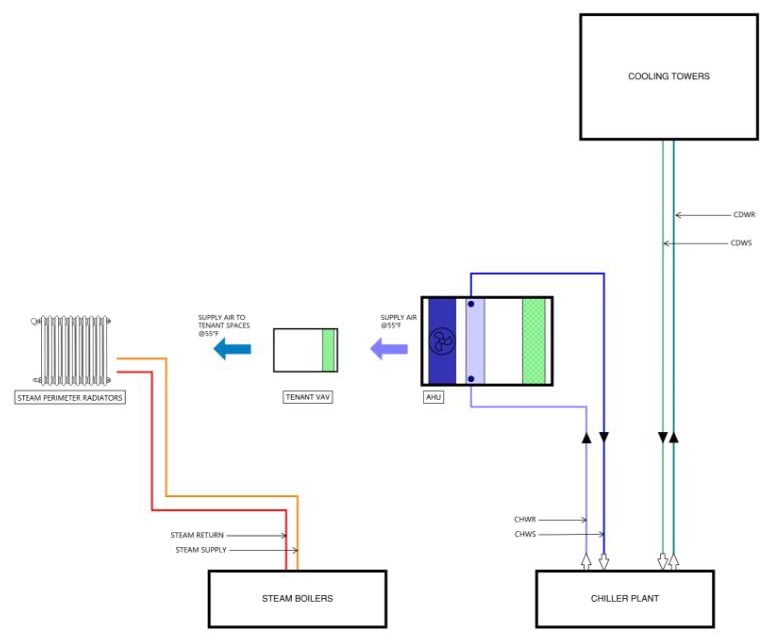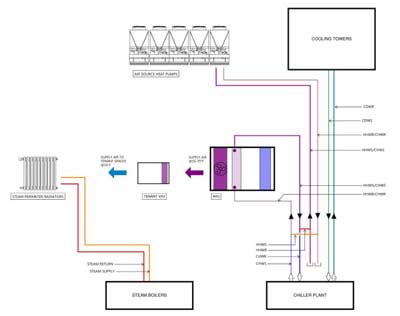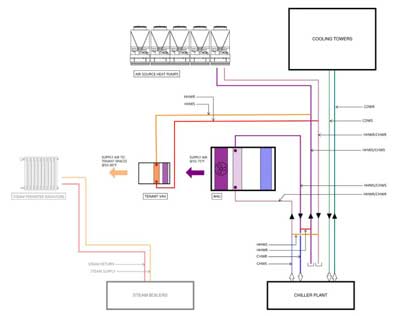250 West 57th Street
New York County

Air-to-Water Heat Pumps Are Applied to a Hydronic Heating and Cooling System for Increased Efficiency
A two-step approach, phased to optimize current building infrastructure and budget, enables a large commercial building to use heat pump technology to reduce emissions and improve efficiency.
250 West 57th Street is a mixed-use commercial property with more than 500,000 square feet of retail and office space. It has two healthy building certifications (WELL Health Safety, Fitwel) and a recent ENERGY STAR® rating of 76.
The building is owned by Empire State Realty Trust (ESRT), a leader in energy efficiency, sustainability, and healthy buildings.

NYSERDA Program: FlexTech
Location: Manhattan
Type: Commercial/ retail + office
Size: 527,600 sq ft
Project members: ESRT and Buro-Happold
System replaced (Phase 1): Steam boiler plant
New system (Phase 1): Air-to-water heat pumps & heating hot water riser
Anticipated annual natural gas savings (end of Phase 1): $80,000 and 6,220 MMBTU
Anticipated annual carbon savings (end of phase 2): 300 tCO2e
When ESRT applied to NYSERDA’s FlexTech program, it wanted to develop a business case for emissions reduction. ESRT also had a list of goals in hand for an energy management team that included: an extensive existing system survey; an evaluation of the building’s potential for net-zero pathways and associated techno-economic review; an analysis of the effectiveness of a whole-building approach; and more.
Current Systems + Equipment:
The hydronic (water-based) heating and cooling systems included a mix of technologies and components. Some components had recent installation dates, while others were moving toward end-of-useful-life.
Cooling system:
- Central chiller plant
- Cooling towers with cells (consumes 7% of total building energy) – installed 2015
- Two 325-ton water-cooled chillers – installed 1999
Heating system:
- Natural gas-to-steam boiler plant (consumes 38.8% of total building energy)
- Two low-pressure steam boilers - installed in 1996 and 2003
- Steam perimeter radiators
- Electric unit heaters
The Energy Study (Assessment)
ESRT chose Buro Happold (BH), a Flextech Consultant, to perform the energy study. The study, which began in Spring 2021, included site visits, building testing, electrical infrastructure assessment, and documentation review.
BH pinpointed four primary challenges:
- A natural gas component -- a source of emissions and inefficiencies -- would need to be replaced.
- Limited capacity in the existing central plant system, which is composed of water-cooled chillers installed in 1999, and cooling towers installed in 2015.
- Nearly one hundred tenants that would require heating/cooling retrofits with minimal disruption.
- Budget considerations.
Why use air-to-water heat pumps at 250 West 57th Street?
Instead of replacing the existing water-cooled chillers in kind, air-to-water heat pumps were selected. The critical benefit of air-to-water heat pumps is that they offer a higher heat output for each unit of energy input compared to electric resistance and traditional fuel sources. AWHPs are transferring energy, not generating it.
In this instance, AWHPs solve multiple problems.
They:
- meet an immediate need for additional cooling capacity
- enable the building to shift away from installing hybrid direct expansion (DX) units on tenant floors for after-hours cooling, eliminating the need for a refrigerating system operating engineer
- provide a low-carbon solution to heating during cooler weather
- improve the central plant's resiliency
The new heat pump installation will be tied into the existing chilled water system as well as a new hot water riser. Although it will take several years for the tenants to tie completely into the new hot water riser as fit outs are completed, heating from the heat pumps will still be able to be utilized on Day 1 because the existing chilled water system will be converted into a change-over system, which allows heating via the existing AHU cooling coils.
The five AWHPs, expected during 2024, carry a substantial load:
- Cooling: 55.4 tons each, 277 tons total
- Heating: 569.4 MBH each, 2,847 MBH total
FAST FACT:
Air-to-water heat pumps won the EPAs “emerging technology” award in 2019.
1: Existing System
Opportunities for electrification
- Cooling towers on roof distributing CDW to the cellar chiller plant.
- Chillers use CDW to generate CHW that goes to the tenant AHUs for supply air at 55°F.
- VAVs (variable air volume) serve supply air from the conditioned air from AHUs, without opportunity for further zone temperature control.
- Steam boilers generate steam to distribute to perimeter steam radiators for heating tenant spaces
A schematic of the existing heating/cooling system. (Credit: Buro Happold. Used with permission.)

Phase-One Recommendations
In November 2021, the BH energy management team presented its two-phase recommendation. Phase One included:
- roof installation of five modular air-to-water heat pumps
- a new heating hot water riser
- electric riser installation to accommodate Phase Two AWHP electrical connection
The five heat pumps would be integrated into the existing and new hydronic infrastructure. They would turn the main chilled water riser into a dual temperature change-over system, work with existing air handling units (AHUs), and offset a percentage of the steam heating and chilled water-cooling load on “Day 1.”
Tenant HVAC upgrades would include the tie-in of the VAV system into the new hot water riser to fully electrify the building. Other gradual upgrades that were recommended – which included public spaces, lighting, and building envelope – could happen on a rolling basis when leases turn over.
2: Proposed System Day 1 Operation
Heating to existing AHU coils to reduce overnight steam usage HHW taps on every floor for future connection to VAV heating coils
- ASHPs provide HHW capabilities to tenant AHUs by tapping into the CHW riser.
- AHUs cooling coils are now dual temperature and can provide hot air, ranging from 55-75°F, to the VAVs.
- Steam boilers and radiators will require less usage and capacity since partial heating will be provided from the AHUs.
A schematic of operations on Day 1. (Credit: Buro Happold. Used with permission.)

Phase-Two Recommendations
Phase Two planned for the installation of additional rooftop air-to-water heat pumps in 2030. When complete, heat pumps would take over the hydronic infrastructure, carry the full heating/ cooling load, and eliminate the need for the existing chiller and boiler.
This two-phase plan was approved in December 2023.
3: Proposed System w/ VAV Reheats
New tenant fitouts to be VAV reheat and connect to new HHW riser
- The HHW taps from the HHW riser in the fire tower connect into tenant VAV reheat coils.
- Steam boilers and radiators will require even less usage and capacity since heating will mainly be provided from ASHPs to tenant AHUs and VAV reheats. VAVs can further adjust the AHU supply air to temperatures between 55-85°F.
- Electrification comes from less reliance on the steam system and the chiller plant.
A schematic that shows VAV coils, with decreased reliance on the steam system. (Credit: Buro Happold. Used with permission.)

Pursuit of Net-Zero
ESRT’s working definition of net-zero existing buildings has three parts:
- Drastically reduce building operational emissions
- Partner with a renewably sourced grid aligned with New York’s Climate Act
- Offset residual emissions through clean energy generation and/or renewable energy certificates (RECs) that use a transparent accounting and reporting process
Following these steps, ESRT’s net annual building operational carbon emissions -- once the two phases are complete -- will be equal to zero.
In addition, by 2035, the ESRT portfolio will target net-zero emissions through an 80% operational carbon reduction. This will be achieved through a combination of energy efficiency measures, a more renewably sourced grid, a 20% offset with off-site clean energy generation, and RECs.
Lessons Learned
The team offered up a few tips to others prepared to phase in clean energy upgrades:
- When opportunities or needs arise to replace equipment, utilize the opportunity to promote carbon and energy efficiency.
- Strategically time carbon and energy efficiency improvements based on the service life of existing equipment. This improves the payback and ROI of these improvements due to the low incremental cost compared to replacement in kind.
The NYSERDA Flexible Technical Assistance (FlexTech) Program supports New York State Commercial, Industrial and Multifamily customers by providing a cost-share for credible, objective technical assistance services. These services may include, but are not limited to, targeted or comprehensive energy studies, retro-commissioning studies, electrification/electrification readiness studies, and energy master planning.
A summary of eligible cost-shared services and service definitions can be found on the FlexTech Documents and Resources page.
This case study is based upon the services provided and graphics created by Buro Happold Consulting Engineers P.C.
Discover how to reduce energy costs and incorporate clean energy.
Visit NYSERDA’s FlexTech program to learn more.
